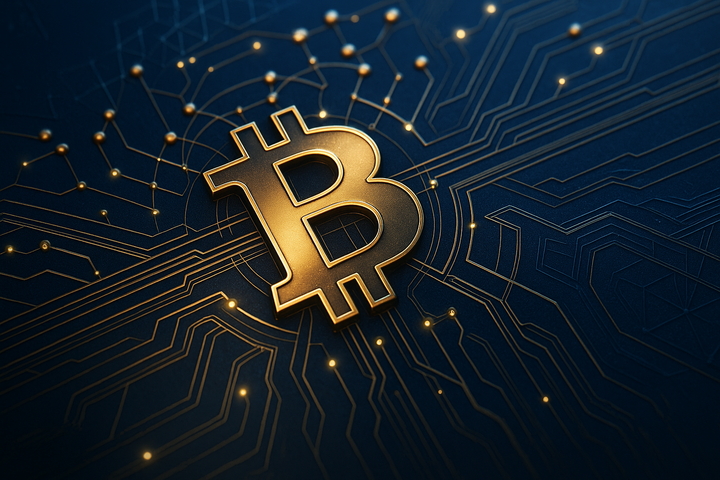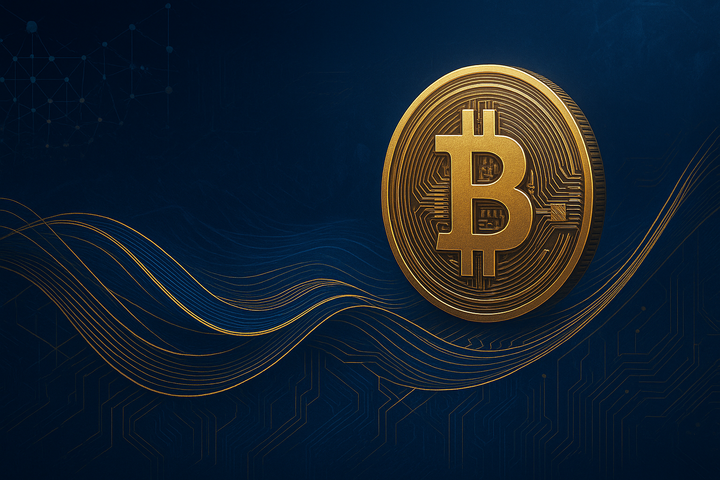Dollar Decline, Gold Revaluation, and Bitcoin’s Reserve Role
The August 17, 2025 episode of Miles Franklin Media features Michelle Makori interviewing Luke Gromen, who explains how U.S. policymakers are managing a weaker dollar to restore industrial capacity and security.

- My 'briefing notes' summarize the content of podcast episodes; they do not reflect my own views.
- They contain (1) a summary of podcast content, (2) potential information gaps, and (3) some speculative views on wider Bitcoin implications.
- Pay attention to broadcast dates (I often summarize older episodes)
- Some episodes I summarize may be sponsored: don't trust, verify, if the information you are looking for is to be used for decision-making.
Summary
The August 17, 2025 episode of Miles Franklin Media features Michelle Makori interviewing Luke Gromen, who explains how U.S. policymakers are managing a weaker dollar to restore industrial capacity and security. He argued that gold has overtaken Treasuries as the primary reserve asset while Bitcoin, through its link to stablecoins, is emerging as a U.S.-aligned alternative. These insights underscore the systemic transition away from debt-based reserves toward neutral assets in a shifting monetary order.
Take-Home Messages
- Dollar Strategy: U.S. leaders are deliberately weakening the dollar to reshore industry and restore security.
- Reserve Shift: Central banks have reduced Treasury holdings while increasing gold reserves since 2014.
- Gold Revaluation: Proposals to link or revalue gold aim to stabilize U.S. debt markets and cut borrowing costs.
- Bitcoin Linkage: Bitcoin’s correlation with stablecoin growth ties it directly to Treasury financing and U.S. policy interests.
- Systemic Reset: The rivalry between gold and Bitcoin will determine the future architecture of global reserves.
Overview
Luke Gromen explained that the dollar’s global reserve role has become unsustainable, as persistent deficits have eroded U.S. industrial capacity and created national security vulnerabilities. He linked these developments to Triffin’s dilemma, arguing that the system has reached its limits. The current USA administration, including Trump and senior officials, now views dollar devaluation as necessary to restore productive strength.
He noted that central banks have already moved decisively away from Treasuries, selling $2.3 trillion since 2014 while accumulating over $600 billion in gold. China has used gold to secure energy imports and promote yuan-denominated trade, directly challenging the dollar’s dominance. This trend highlights how gold has displaced Treasuries as the preferred neutral reserve asset at the global level.
Gromen argued that Washington is experimenting with mechanisms to stabilize its fiscal position, including proposals for gold-linked bonds and statutory revaluation of gold on the Treasury’s balance sheet. Such measures could reduce borrowing costs and alleviate long-term debt pressures. He suggested these steps may soon be unavoidable, given that U.S. interest obligations now exceed government receipts.
Bitcoin, he observed, represents a parallel development. By linking stablecoins to Treasury bills under recent legislation, policymakers have opened a channel that connects Bitcoin adoption to U.S. debt financing. Gromen concluded that both gold and Bitcoin are rising as neutral reserves, but their rivalry will determine how monetary power is restructured in the decades ahead.
Stakeholder Perspectives
- U.S. policymakers: Balancing the risks of dollar devaluation with the goal of restoring productive capacity and preserving payment system dominance.
- Global central banks: Prioritizing gold as a stable, trusted asset to replace Treasuries in their reserves.
- Bitcoin advocates: Promoting Bitcoin’s role as a neutral reserve asset aligned with U.S. technological and fiscal interests.
- China and Russia: Using gold accumulation and yuan-based settlement to counter U.S. monetary leadership.
- Investors: Tracking gold revaluation and Bitcoin’s policy trajectory to anticipate systemic financial shifts.
Implications and Future Outlook
The managed decline of the dollar signals a systemic reset in global finance. For the USA, devaluation paired with gold revaluation or gold-linked bonds could provide temporary fiscal relief, while enabling reshoring of industry and a stronger defense base. However, execution risks are high, and failure to coordinate these shifts could trigger market instability.
Gold’s role as a reserve asset is reinforced by central bank demand, but its alignment with China and Russia poses strategic dilemmas for Washington. U.S. policymakers may view Bitcoin, connected through stablecoins to Treasury financing, as a way to counterbalance this geopolitical tilt. The outcome of this rivalry will determine whether monetary multipolarity consolidates around metals, digital assets, or both.
The broader trajectory is toward diversification away from debt-backed reserves. Decision-makers will need to prepare for a future where gold and Bitcoin gain influence while the dollar loses its singular status. This realignment will reshape trade, investment, and security strategies across global institutions and governments.
Some Key Information Gaps
- What global consequences will follow from a deliberate USA policy of dollar devaluation? Understanding trade, alliance, and stability effects is critical for anticipating systemic risks.
- How sustainable is the ongoing central bank shift from Treasuries to gold? Clarifying this trend will determine the durability of gold’s role as a neutral reserve.
- What mechanisms could formalize Bitcoin’s role as a neutral reserve asset? Identifying pathways ensures informed policy on adoption, regulation, and stability.
- What practical models exist for Treasury gold bonds or official revaluation? Exploring design options is vital for assessing fiscal feasibility and credibility.
- How severe could AI-driven job losses become for debt servicing capacity? Linking labor market disruptions to fiscal solvency is essential for long-term planning.
Broader Implications for Bitcoin
Global Reserve Fragmentation
The decline of dollar primacy suggests a future where multiple assets serve as neutral reserves. Gold and Bitcoin could anchor competing blocs, splitting global finance into parallel systems. This fragmentation would increase complexity in trade, investment, and security planning for governments and corporations.
Technology-Driven Monetary Competition
Bitcoin’s rise reflects not just monetary demand but U.S. dominance in digital infrastructure. If stablecoins deepen ties between Bitcoin and Treasury financing, technology may become a decisive factor in reserve competition. This creates new dependencies on cybersecurity, interoperability, and governance of digital financial systems.
Fiscal Innovation and Constraints
Mechanisms like gold revaluation or Bitcoin-linked instruments signal a growing reliance on unconventional fiscal tools. While these may temporarily relieve pressure, they also highlight structural weaknesses in debt-based systems. The need for innovation may drive both opportunity and instability as governments test unorthodox solutions.
Strategic Realignment of Power
As gold and Bitcoin grow in reserve prominence, geopolitical alignments may shift toward resource holders and technology leaders. States with significant gold reserves or robust Bitcoin ecosystems will gain leverage. This realignment could weaken U.S. allies that fail to adapt and empower emerging powers outside the traditional Western sphere.



Comments ()